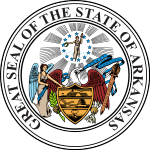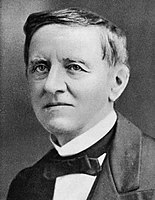
The 1876 United States presidential election was the 23rd quadrennial presidential election, held on Tuesday, November 7, 1876. Incumbent Republican president Ulysses S. Grant declined to run for a third term, so the party chose Rutherford B. Hayes, the governor of Ohio, as its nominee. The Democratic Party nominated New York governor Samuel J. Tilden as their nominee. It was one of the most contentious presidential elections in American history. Its resolution involved negotiations between the Republicans and Democrats, resulting in the Compromise of 1877, and on March 2, 1877, the counting of electoral votes by the House and Senate occurred, confirming Hayes as President. It was the second of five U.S. presidential elections in which the winner did not win a plurality of the national popular vote. This is the first time it happened since 1824.

Samuel Jones Tilden was an American politician who served as the 25th governor of New York and was the Democratic nominee in the disputed 1876 United States presidential election.

The Electoral Commission, sometimes referred to as the Hayes-Tilden or Tilden-Hayes Electoral Commission, was a temporary body created by the United States Congress on January 29, 1877, to resolve the disputed United States presidential election of 1876. Democrat Samuel J. Tilden and Republican Rutherford B. Hayes were the main contenders in the election. Tilden won 184 undisputed electoral votes, one vote shy of the 185 needed to win, to Hayes' 165, with 20 electoral votes from four states unresolved. Both Tilden and Hayes electors submitted votes from these states, and each claimed victory.

The 1876 United States presidential election in California was held on November 7, 1876, as part of the 1876 United States presidential election. State voters chose six representatives, or electors, to the Electoral College, who voted for president and vice president.

The 1876 United States elections were held on November 7. In one of the most disputed presidential elections in American history, Republican Governor Rutherford B. Hayes of Ohio ended up winning despite Democratic Governor Samuel J. Tilden of New York earning a majority of the popular vote. The Republicans maintained their Senate majority and cut into the Democratic majority in the House.

The 1876 United States presidential election in New York took place on November 7, 1876. All contemporary 38 states were part of the 1876 United States presidential election. Voters chose 35 electors to the Electoral College, which selected the president and vice president.

The 1876 United States presidential election in Virginia took place on November 7, 1876, as part of the 1876 United States presidential election. Voters chose 11 representatives, or electors to the Electoral College, who voted for president and vice president.

The 1876 United States presidential election in Louisiana took place on November 7, 1876, as part of the 1876 United States presidential election. Voters chose eight representatives, or electors to the Electoral College, who voted for president and vice president.

The 1876 United States presidential election in Connecticut took place on November 7, 1876, as part of the 1876 United States presidential election. Voters chose six representatives, or electors to the Electoral College, who voted for president and vice president.

The 1876 United States presidential election in Rhode Island took place on November 7, 1876, as part of the 1876 United States presidential election. Voters chose four representatives, or electors to the Electoral College, who voted for president and vice president.

The 1876 United States presidential election in South Carolina took place on November 7, 1876, as part of the 1876 United States presidential election. Voters chose 7 representatives, or electors to the Electoral College, who voted for president and vice president.

The 1876 United States presidential election in Ohio was held on November 7, 1876 as part of the 1876 United States presidential election. State voters chose 22 electors to the Electoral College, who voted for president and vice president.

The 1876 United States presidential election in Colorado took place on November 7, 1876, as part of the 1876 United States presidential election. The state legislature chose three representatives, or electors to the Electoral College, who voted for president and vice president, which would be the first and only time the state would do so.

The 1876 United States presidential election in Michigan took place on November 7, 1876, as part of the 1876 United States presidential election. Voters chose 11 representatives, or electors, to the Electoral College, who voted for president and vice president.

The 1876 United States presidential election in West Virginia took place on November 7, 1876, as part of the 1876 United States presidential election. West Virginia voters chose five representatives, or electors, to the Electoral College, who voted for president and vice president.

The 1876 United States presidential election in Tennessee took place on November 7, 1876, as part of the 1876 United States presidential election. Tennessee voters chose twelve representatives, or electors, to the Electoral College, who voted for president and vice president.

The 1876 United States presidential election in North Carolina took place on November 7, 1876, as part of the 1876 United States presidential election. North Carolina voters chose 10 representatives, or electors, to the Electoral College, who voted for the president and vice president.

The 1876 United States presidential election in Florida took place on November 7, 1876, as part of the 1876 United States presidential election. Florida voters chose four representatives, or electors, to the Electoral College, who voted for president and vice president.

The 1876 United States presidential election in Kansas took place on November 7, 1876, as part of the 1876 United States presidential election. Voters chose five representatives, or electors to the Electoral College, who voted for president and vice president.

The 1876 United States presidential election in Missouri took place on November 7, 1876, as part of the 1876 United States presidential election. Voters chose 15 representatives, or electors to the Electoral College, who voted for president and vice president.
























